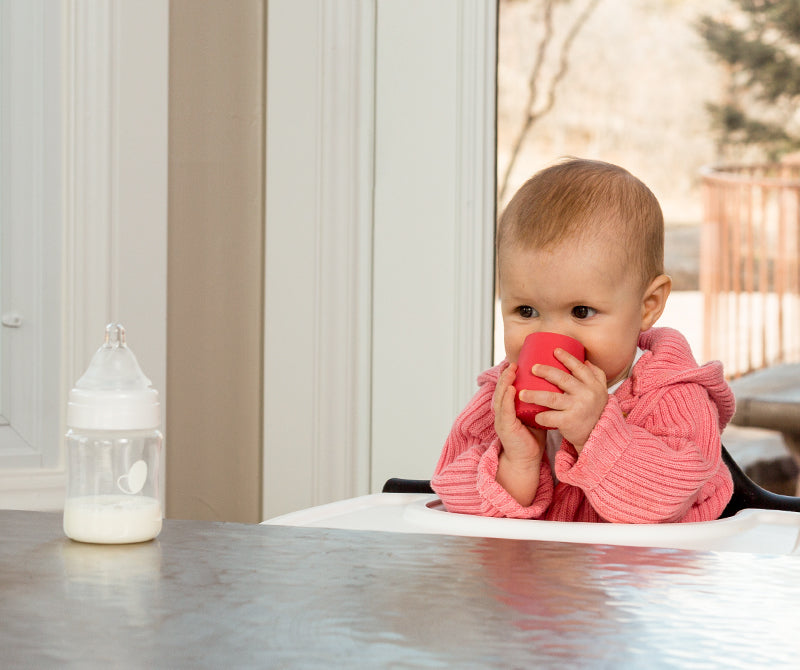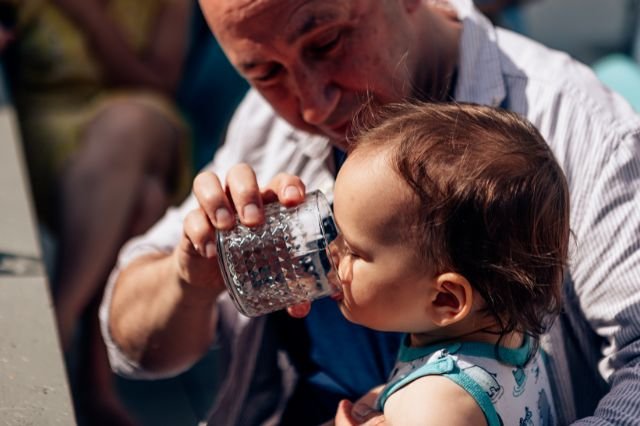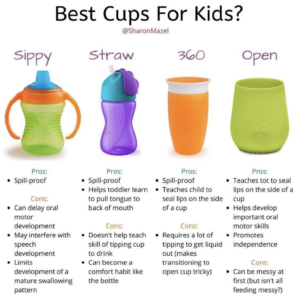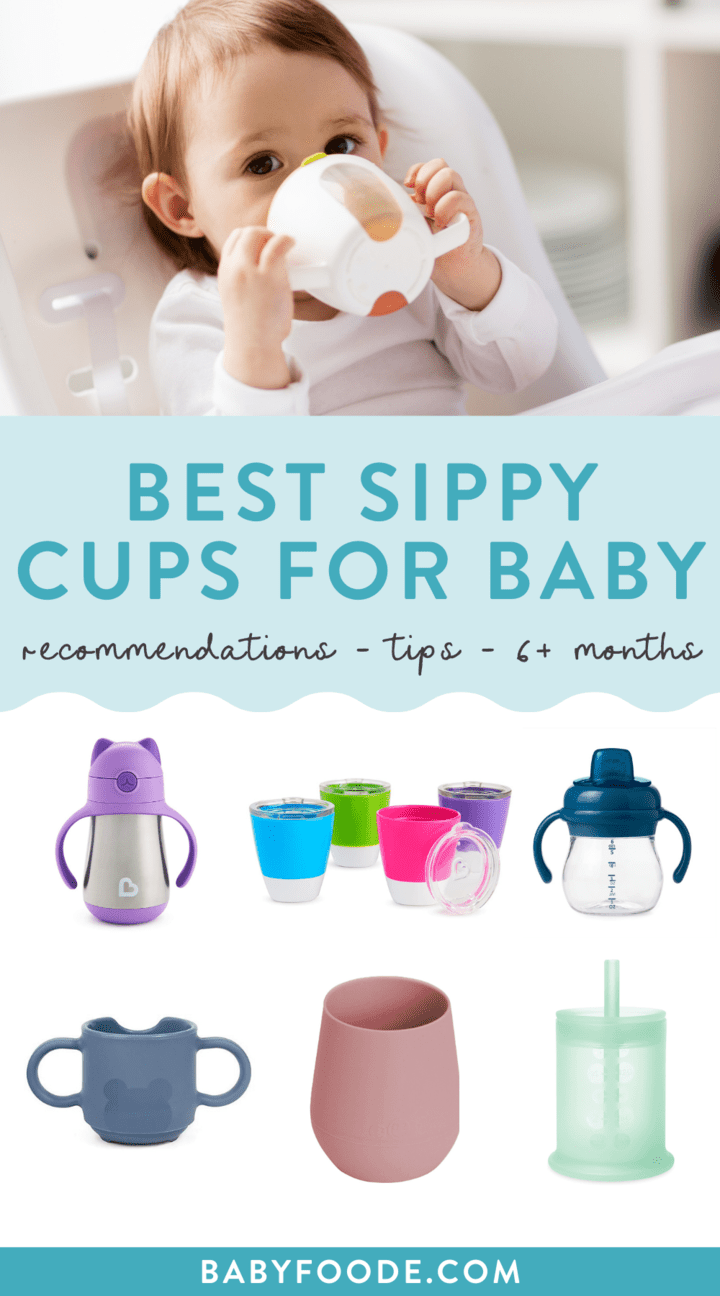
Transitioning from bottle to a cup can be a hard process for baby and the entire family. I believe this is why I have seen so many babies maturing into toddlerhood and refusing to drink out of anything other than a bottle (these kiddos typically need a few sessions of feeding therapy to help with the process). Therapy,
Transitioning from bottle to a cup can be a hard process for baby and the entire family. I believe this is why I have seen so many babies maturing into toddlerhood and refusing to drink out of anything other than a bottle (these kiddos typically need a few sessions of feeding therapy to help with the process). Therapy, refusals and frustration can be avoided if parents have a grasp of how to implement the strategies I teach. Here are three reasons to switch from a bottle to an open cup by 12 months of age, plus tips to help prepare baby for a gentle transition off the bottle.
Developmental Reasons: A baby should be proficient at holding an open cup and drinking from it (with some spillage) by 12 months of age. Knowing that baby can make this developmental achievement may inspire you to practice open cup drinking to help baby slowly wean off a bottle. Here are a few tips on when to start:
Introduce a cup at 6 months of age. Developmentally a baby should start to have sips of breast milk or formula from an open cup (held by an adult) at 6 months of age. With practice, baby will slowly hold on to the cup, have good lip closure on the rim, tilt the liquid gently and learn to spill less. If you start at 6 months, then you will have an additional 6 months of cup-drinking repetition before baby transitions off a bottle at 12 months. By then, baby will have the skills to drink independently and can graduate to a cup full time!
Practice with a small amount. Try using the ezpz Tiny Cup; it is only 2 ounces in size! Fill it with a half an ounce to start, and gradually move to one ounce, then two.
Safety Reasons: I have seen several kiddos take a tumble while they were walking around with a bottle hanging from their mouth. In fact, a toddler is rushed to the hospital every 4 hours because of injuries sustained from the overuse of bottles, Sippy cups or pacifiers. Not only is this painful, it can also lead to mealtime behaviors and/or trust issues surrounding nourishment. To avoid this, here are some tips:
Practice sitting. Have baby practice sitting at the table with you when drinking from a bottle. This will give baby mealtime exposure (sitting at the table, one-on-one connection, feeling full, etc.), which you’ll be thankful for when you introduce solids.
Use tools with sensory protection. Practice drinking from a safe open cup, like the Tiny Cup or a straw cup, such as the Mini Cup + Straw Training System. Both of these items are also a part of the Developmental Cup Set. Psst the set offers a significant discount!
Dental Reasons: To prevent tooth decay, the American Dental Association recommends transitioning a baby from a bottle to a cup by baby’s first birthday. This will help decrease any picky drinking habits like sleeping with a bottle at night, which increases the risk for cavities.
Open cup vs. Sippy cup. There are many cups on the market for parents to choose from, and it can be overwhelming. That's why I teach parents to make decisions based on development. Most parents believe they are supposed to transition their baby from breast / bottle to a Sippy cup around 6 months of age. Unfortunately, this is false feeding advice. Baby should transition from breast / bottle to sips from an open cup held by a parent between 4-6 months and a straw cup around 9 months.
By 12 months of age baby will be eating three small meals a day and drinking independently from an open cup and straw cup. So, offer breast milk or formula in an open cup or straw cup before bed as an alternative to a bottle.
Implement a new routine. Initiate a new routine of singing, reading or cuddling to help soothe your baby to sleep rather than giving a bottle.
I know that feeding is hard and graduating from bottle to an open cup + straw cup can seem daunting. But I hope these tips will help support you on your feeding journey and make the transition as smooth as possible! What are some of your ideas for switching baby from bottle to cup? #ezpzfun
How to Transition Your Baby From a Bottle to a Sippy Cup With Ease

Best Sippy Cups
:max_bytes(150000):strip_icc()/nuk-simply-natural-learner-cup-2dfa0311c6254e6993b58b2d2e3f0d9c.jpg)
The Best Sippy Cups for Babies and Toddlers

When Should a Toddler Drink from an Open Cup? And other Cup
Commodity shopping platform Choosing Between a Sippy Cup and a
Thoughtfully Designed: The ezpz Mini Cup + Straw Training System teaches older babies + toddlers to drink from an open cup and safely learn to use a

ezpz Mini Cup + Straw Training System - 12 Months+ (Blue) - 100% Silicone Training Cup for Infants + Toddlers - Designed by a Pediatric Feeding

Hallie Bulkin - 🗣 Let's talk cups! 🥤When do we start

Best Cups for Baby – Sharon Mazel
Soft and comfortable for little hands and mouths, the ezpz Mini Cup and Straw teaches toddlers to drink from an open cup and safely learn to use a

Mini Cup & Straw
/www.ezpzfun.com%2Fproducts%2Fdevelopmental-cup-set%2F1675477499%2Fezpz_developmentalsets_1200x1200_cups_coral_1.jpg)
Ezpz Developmental Cup Set on Marmalade

Best Sippy Cups for Baby 2024 (expert review)

10 Best Sippy Cups of 2023